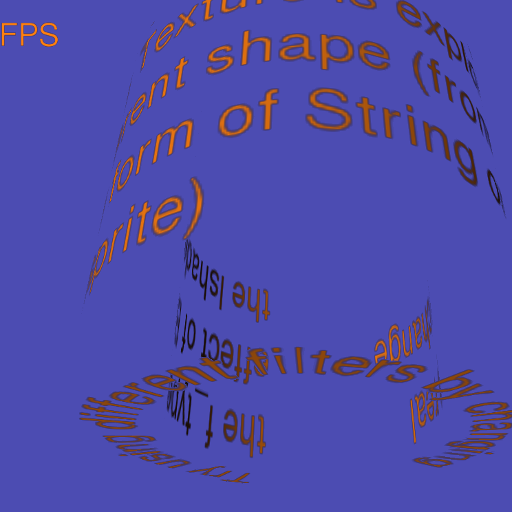Strings¶
pi3d has three mechanisms for producing Text:
The first one is the pi3d.String class which inherits from pi3d.Shape in the same way as the “standard” shapes such as Cuboid, Sphere, Sprite, Torus etc. However as it is initialised it constructs its vertices and texture coordinates to map rectangles from a special Texture - pi3d.Font or pi3d.Pngfont. Each of these classes contain an image of all the letters required and a dictionary to look up the location, width and height of each letter. pi3d.Font is generally more useful as it is generated “on the fly” from a TrueType font but it requires certain functionality from the Python Imaging Library, and where that might not be available (I couldn’t get it to work on Android), pi3d.Pngfont can be used (but it’s restricted to the letters on the special png image files)
The second mechanism is the pi3d.FixedString class which inherits from pi3d.Texture, a bit like the pi3d.Font class above but rather than containing the full alphabet it uses a string passed to the constructor. This means that the string can then be drawn using only four vertices and two triangles rather than that number for every letter required by pi3d.String, so it can be quite a bit faster on some platforms if there’s lots of text. Another of advantage of FixedString is that PIL [1] and numpy can be used to provide filters: BUMP will generate a normal map, EMBOSS, CONTOUR, BLUR and SMOOTH do what you would expect. The FixedString class can be used wherever a pi3d.Texture would be used, but it also contains an instance of pi3d.Sprite (called pi3d.FixedString.sprite) which has width, height, umult and vmult to match the dimensions of the string to the Texture. (Look back at the chapter Shapes, Buffers and Display if you don’t remember umult and vmult!)

However for varying text (such as a score, or timer) the overhead of creating a new PIL image and converting it to a Texture every frame would be large and in this case it is better to use either use the pi3d.String.quick_change() method or the pi3d.PointText class. This latter method has only been added to pi3d as of v2.8 it is rather complicated but very fast and flexible, if you need this then study pi3d_demos/StringMulti.py. Both the approaches have various restrictions as described in the documentation, the most significant of which is that the string can’t be changed to a longer length than its original scope (of course it should be padded by spaces initially for this eventuality).
Have a play with the three examples strings01.py, strings02.py and strings03.py [2] There are one or two quirks to watch out for: if you use a 2D Camera (orthographic - argument is_3d=False) with a pi3d.String object, then you also need to set the argument in the String constructor to is_3d=False. Also the font passed to pi3d.String constructor is a pi3d.Font object but the font passed to pi3d.FixedString is the path to a TrueType font as a string.
With the rotating text you will have noticed the strange effect of the mipmaps which are a series of lower resolution texture maps that automatically get swapped depending on the z depth of the fragment being rendered. The mipmaps are generated at the time of Texture creation and are generally a good thing so the default argument to Texture is mipmap=True.
Check out the use of strings in various of the pi3d_demos.
| [1] | Python Image Library - generally Pillow https://pypi.python.org/pypi/Pillow |
| [2] | https://github.com/paddywwoof/pi3d_book/blob/master/programs/strings01.py |